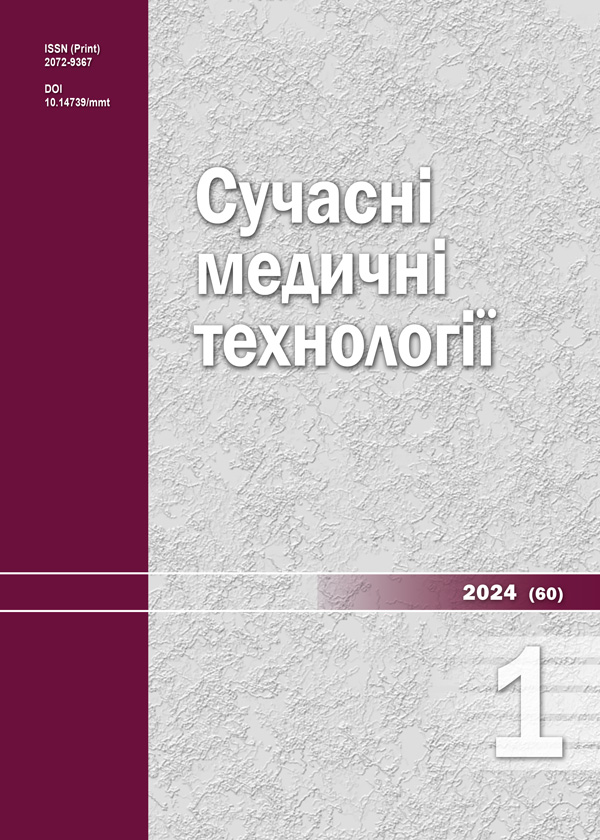Intracardiac 3D navigation as a tool to improve the efficiency of ablation of idiopathic ventricular arrhythmias
DOI:
https://doi.org/10.14739/mmt.2024.1.298462Keywords:
extrasystole, ventricular arrhythmia, electrophysiology, 3D navigation, ablationAbstract
Aim. Еvaluate the effect of 3D navigation on the effectiveness of ablation idiopathic ventricular arrhythmias.
Materials and methods. The paper presents a retrospective postoperative analysis of 57 patients with idiopathic ventricular arrhythmias. Patients were divided into two groups. Group I included 30 (52.6 %) patients who used a 3D navigation system during mapping. Group II – 27 (47.4 %) patients in whom mapping was performed using classical methods. The effectiveness criteria were: frequency of acute suppression of arrhythmia, number of radiofrequency applications for suppression, and time of intervention.
Results. Intraoperatively, complete suppression of the arrhythmia was successfully achieved in all cases in both groups. In group I average number of applications in patients with ventricular extrasystole was 5.5 (4.0; 8.0), while in group II – 6.5 (3,5; 9.0), without statistically significant difference (p = 0.414). A similar situation was observed with ventricular tachycardia. Іn group I number of applications was 3.2 (3.0; 4.3), and in group II – 5.0 (2.3; 11.0), which also had no statistically significant difference (р = 0.537). The duration of intervention for ventricular extrasystole in group I was 100.6 ± 26.6 min, while in group II – 136.4 ± 42.2 min, that has statistically significant difference (p = 0.007). During ablation of ventricular tachycardia in group I average duration was 89.3 ± 20.4 min, while in group II – 135.4 ± 55.5 min. The duration of intervention for ventricular tachycardia with the use of 3D navigation had a significantly shorter time compared to classical methods (p = 0.024).
Conclusions. Based on the obtained data, we concluded that the use of 3D navigation significantly reduced the intervention time, regardless of the localization and type of arrhythmia. At the same time, no significant difference was found in the frequency of acute arrhythmia suppression and the number of applications to achieve the effect between the studied groups.
References
Pelliccia A, De Martino L, Borrazzo C, Serdoz A, Lemme E, Zorzi A, et al. Clinical correlates and outcome of the patterns of premature ventricular beats in Olympic athletes: a long-term follow-up study. Eur J Prev Cardiol. 2020;28(10):1038-47. doi: https://doi.org/10.1177/2047487320928452
Al-Khatib SM, Stevenson WG, Ackerman MJ, Bryant WJ, Callans DJ, Curtis AB, et al. 2017 AHA/ACC/HRS Guideline for Management of Patients With Ventricular Arrhythmias and the Prevention of Sudden Cardiac Death: Executive Summary: A Report of the American College of Cardiology/American Heart Association Task Force on Clinical Practice Guidelines and the Heart Rhythm Society. Circulation. 2018;138(13):e210-e271. doi: https://doi.org/10.1161/CIR.0000000000000548
Zeppenfeld K, Tfelt-Hansen J, de Riva M, Winkel BG, Behr ER, Blom NA, et al. 2022 ESC Guidelines for the management of patients with ventricular arrhythmias and the prevention of sudden cardiac death. Eur Heart J. 2022;43(40):3997-4126. doi: https://doi.org/10.1093/eurheartj/ehac262
Klewer J, Springer J, Morshedzadeh J. Premature Ventricular Contractions (PVCs): A Narrative Review. Am J Med. 2022;135(11):1300-5. doi: https://doi.org/10.1016/j.amjmed.2022.07.004
De Silva K, Haqqani H, Mahajan R, Qian P, Chik W, Voskoboinik A, et al. Catheter Ablation vs Antiarrhythmic Drug Therapy for Treatment of Premature Ventricular Complexes: A Systematic Review. JACC Clin Electrophysiol. 2023;9(6):873-85. doi: https://doi.org/10.1016/j.jacep.2023.01.035
Hayashi T, Liang JJ, Shirai Y, Kuo L, Muser D, Kubala M, et al. Trends in Successful Ablation Sites and Outcomes of Ablation for Idiopathic Outflow Tract Ventricular Arrhythmias. JACC Clin Electrophysiol. 2020;6(2):221-30. doi: https://doi.org/10.1016/j.jacep.2019.10.004
Hanson M, Futyma P, Bode W, Liang JJ, Tapia C, Adams C, et al. Catheter ablation of intramural outflow tract premature ventricular complexes: a multicentre study. Europace. 2023;25(5):euad100. doi: https://doi.org/10.1093/europace/euad100
Asatryan B, Seiler J, Bourquin L, Knecht S, Servatius H, Madaffari A, et al. Pre-procedural arrhythmia burden and the outcome of catheter ablation of idiopathic premature ventricular complexes. Pacing Clin Electrophysiol. 2021;44(4):703-10. doi: https://doi.org/10.1111/pace.14211
Haanschoten DM, Vernooy K, Beukema RJ, Szili-Torok T, Ter Bekke RM, Khan M, et al. Elimination of Benign Ventricular Premature Beats or Ventricular Tachycardia with Catheter Ablation versus Two Different Optimal Antiarrhythmic Drug Treatment Regimens (Sotalol or Verapamil/Flecainide). Cardiology. 2020;145(12):795-801. doi: https://doi.org/10.1159/000509661
Muser D, Tritto M, Mariani MV, Di Monaco A, Compagnucci P, Accogli M, et al. Diagnosis and Treatment of Idiopathic Premature Ventricular Contractions: A Stepwise Approach Based on the Site of Origin. Diagnostics (Basel). 2021;11(10):1840. doi: https://doi.org/10.3390/diagnostics11101840
Sousa PA, Barra S, Cortez-Dias N, Khoueiry Z, Paulo J, António N, et al. Multielectrode mapping for premature ventricular contraction ablation - A prospective, multicenter study. Int J Cardiol. 2023;383:33-9. doi: https://doi.org/10.1016/j.ijcard.2023.04.044
Cai C, Wang J, Niu H, Hua W, Chu J, Zhang S. Multipolar mapping for catheter ablation of premature ventricular complexes originating from papillary muscles in the structurally normal heart: a case series. BMC Cardiovasc Disord. 2020;20(1):464. doi: https://doi.org/10.1186/s12872-020-01747-z
Kim YH, Chen SA, Ernst S, Guzman CE, Han S, Kalarus Z, et al. 2019 APHRS expert consensus statement on three-dimensional mapping systems for tachycardia developed in collaboration with HRS, EHRA, and LAHRS. J Arrhythm. 2020;36(2):215-70. doi: https://doi.org/10.1002/joa3.12308
Merino JL. Tools or Toys? The 20-Year Anniversary of the Nonfluoroscopic Mapping System Dilemma. Rev Esp Cardiol (Engl Ed). 2017;70(9):690-3. English, Spanish. doi: https://doi.org/10.1016/j.rec.2017.05.012
Cronin EM, Bogun FM, Maury P, Peichl P, Chen M, Namboodiri N, et al. 2019 HRS/EHRA/APHRS/LAHRS expert consensus statement on catheter ablation of ventricular arrhythmias. Europace. 2019;21(8):1143-4. doi: https://doi.org/10.1093/europace/euz132
Downloads
Published
How to Cite
Issue
Section
License
The work is provided under the terms of the Public Offer and of Creative Commons Attribution-NonCommercial 4.0 International (CC BY-NC 4.0). This license allows an unlimited number of persons to reproduce and share the Licensed Material in all media and formats. Any use of the Licensed Material shall contain an identification of its Creator(s) and must be for non-commercial purposes only.














